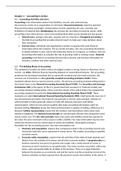Samenvatting
Summary Financial Accounting; Summary Financial and Managerial Accounting, ISBN: 9781119752622 Accounting I (E_EBE1_ACC1)
- Instelling
- Vrije Universiteit Amsterdam (VU)
Summary Financial Accounting; Summary Financial and Managerial Accounting, ISBN: 2622 Accounting I (E_EBE1_ACC1)
[Meer zien]








